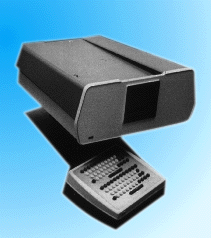 Back to Glen Culler Honorary Lecture Home Page
Back to Glen Culler Honorary Lecture Home Page The UCSB On-Line System (OLS) provides the capability for sophisticated mathematical analysis for use in solving problems where human interaction is either necessary or desired.
The UCSB On-Line System (OLS) provides the capability for sophisticated mathematical analysis for use in solving problems where human interaction is either necessary or desired.OLS accepts both real and complex numbers (scalars) as operands as well as lists of such numbers (vectors). Operations performed on scalars produce scalar results, which can be numerically displayed; operations on vectors produce vector results (the specified operation being performed on each component), and results of computation can be displayed either numerically or graphically. Operands can be stored and used as required. Operators include sine, cosine, logarithm, and exponentiation; and each is executed with a single button push. Facility is provided for interaction between operands of different types (e.g. vectors and scalars). In addition a limited set of operations manipulate integers used in subscripting.
Additional features are provided to support OLS's basic mathematical capability. Although OLS normally executes each button as it is pushed, a button sequence may be defined, named and saved for later execution. Convenient means are provided for editing such sequences. Lists of buttons to be executed can include programmed pauses, allowing manual and programmed activity to be interfaced; as well as branching based upon results of computation. Messages can be composed of alphameric, Greek, and special characters, and displayed. Those characters not specifically provided by OLS may be designed by the user and stored, and then are available for use. A collection of button lists and user-created characters is referred to as a "system." Systems are named and can be permanently stored and later retrieved. Portions of systems may be transferred between systems, and systems may be transferred between users. Sets of real vectors may also be named, permanently stored, and later retrieved.
Apart from OLS's mathematical capability, a recent development provides the ability to create and edit a "deck" of cards and submit it for execution in an OS partition. Data-sets residing on any disk pack within the installation may be fetched, examined, modified (although not permanently), and submitted for execution. work continues in this general field and further developments are expected.
 Back to Glen Culler Honorary Lecture Home Page
Back to Glen Culler Honorary Lecture Home Page
 Back to College of Engineering
Back to College of Engineering